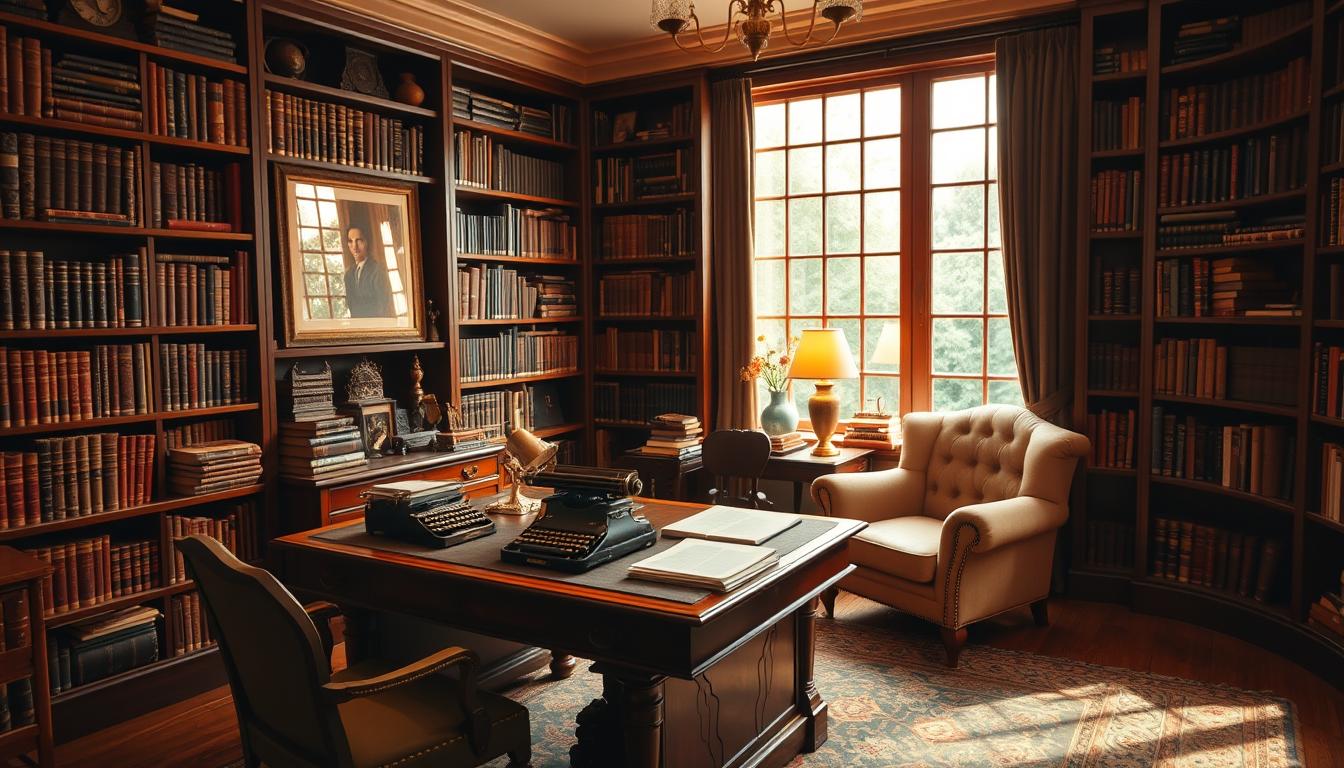Imagine a space where your love for books meets your need for productivity. That’s exactly what I set out to create when I decided to merge my personal library with a functional workspace. It wasn’t just about stacking shelves or placing a desk; it was about crafting a sanctuary that fuels both my creativity and focus.
Combining a library and an office might seem like a challenge, but it’s a rewarding one. I wanted a place where I could dive into my favorite novels while also tackling my daily tasks. With insights from Alison Agley, an architect known for blending aesthetics with functionality, I discovered how to make this dream a reality.
This article will walk you through 11 unique ideas to transform any area into a cozy yet productive haven. Whether you’re a book lover, a remote worker, or both, these tips will help you design a space that honors your passions and needs. Let’s dive in and create a home library office that inspires you every day.
Key Takeaways
- Merge your love for books with a practical workspace for a balanced environment.
- Design a space that supports both reading and working needs.
- Use expert tips to blend style, storage, and functionality seamlessly.
- Create a cozy yet productive haven that inspires creativity.
- Explore 11 unique ideas to transform any area into a home library office.
Define Your Home Library Office Vision
Designing a space that combines work and leisure starts with a clear vision. I began by asking myself what I wanted this room to achieve. Was it a cozy reading nook, a productive workspace, or both? Defining the purpose helped me make informed decisions about furniture, layout, and ambiance.
Clarify Your Space’s Purpose and Function
Understanding the primary function of your room is crucial. For me, it was about balancing productivity with relaxation. I chose ergonomic furniture for work tasks and added plush seating for reading breaks. This dual-purpose approach ensures the space serves all my needs.
Consider how you’ll use the area most often. Will it be for focused work, leisurely reading, or a mix of both? Answering these questions guides your design choices and creates a functional environment.
Blending Work and Reading Ambiance
Merging a productive workspace with a cozy reading nook requires creativity. I focused on lighting to set the tone. Natural light boosts productivity, while warm lamps create a relaxing atmosphere for reading.
Here’s a quick guide to blending these two environments:
| Element | Work Focus | Reading Focus |
|---|---|---|
| Lighting | Bright, natural light | Warm, soft lamps |
| Furniture | Ergonomic desk and chair | Comfortable armchair or sofa |
| Color Scheme | Neutral tones for focus | Warm hues for relaxation |
Small details, like the choice of color and style, can significantly impact the room’s effectiveness. I opted for neutral tones to maintain focus during work hours and added warm accents to make the space inviting for reading.
Establishing clear intentions ensures a balance between productivity and relaxation. Whether it’s through lighting, furniture, or decor, every element should contribute to your vision for the space.
Choosing the Perfect Location & Layout
Finding the right spot for your dual-purpose room can make all the difference. I started by scouting for a quiet, light-filled corner that could serve as both a workspace and a reading nook. Natural light was a priority, as it not only boosts productivity but also reduces eye strain during long reading sessions.
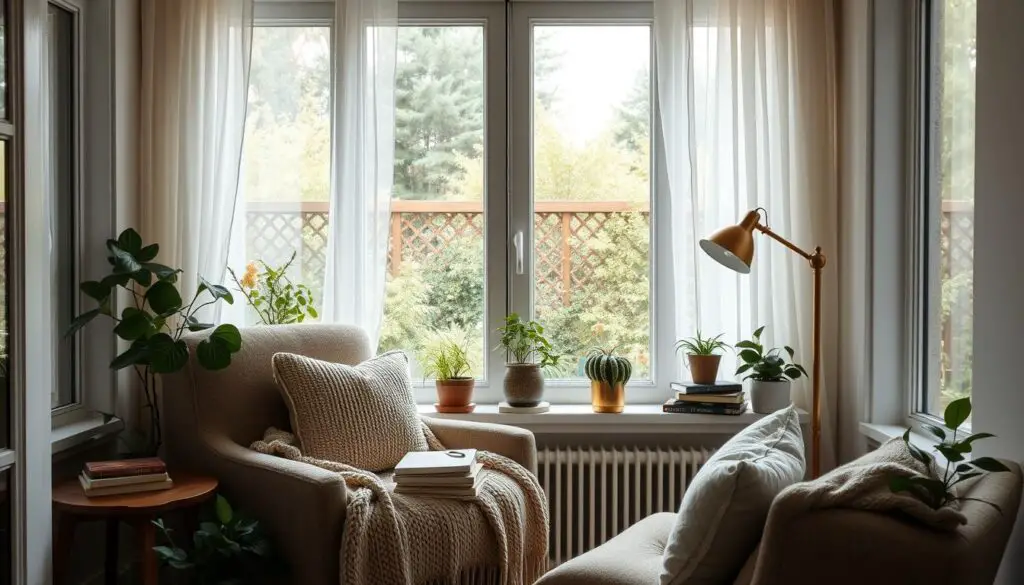
Finding a Quiet, Light-Filled Nook
When choosing a location, I looked for an area with ample natural light. A room with large windows or a skylight was ideal. I also considered the interior layout, ensuring the space felt open and inviting. A peaceful environment was key to maintaining focus and relaxation.
Strategic placement of windows can enhance both ambiance and usability. I positioned my desk near a window to take advantage of the natural light. For reading, I added a cozy armchair in a corner with soft, warm lighting to create a relaxing atmosphere.
Maximizing Space in Every Corner
Even in smaller rooms, every inch of space can be utilized effectively. I explored unconventional areas like under-stair niches and window seats. These spots became functional additions to my dual-purpose room, offering extra storage or seating.
Here are a few tips to maximize your area:
- Use vertical space with tall bookshelves or wall-mounted storage.
- Incorporate multi-purpose furniture, like a desk that doubles as a console table.
- Create zones within the room to separate work and reading areas.
By carefully evaluating the interior and structural attributes, I transformed my chosen space into a functional and inspiring haven. Whether it’s a quiet corner or an unconventional nook, the right location can elevate your dual-purpose room to new heights.
Expert Solutions Home Library Office Design Ideas
Balancing aesthetics with practicality is key to a successful dual-purpose space. When I started designing my room, I focused on blending style with functionality. This approach ensures the area is both visually appealing and highly functional.
Incorporating Stylish Furniture and Ergonomics
Choosing the right furniture was a top priority for me. I wanted pieces that were not only stylish but also ergonomic. A comfortable chair and desk are essential for long hours of work, while a cozy armchair makes reading sessions enjoyable.
I also considered the design of each piece. Clean lines and modern finishes gave the room a polished look. Alison Agley’s advice on blending aesthetics with practicality was invaluable in this process.
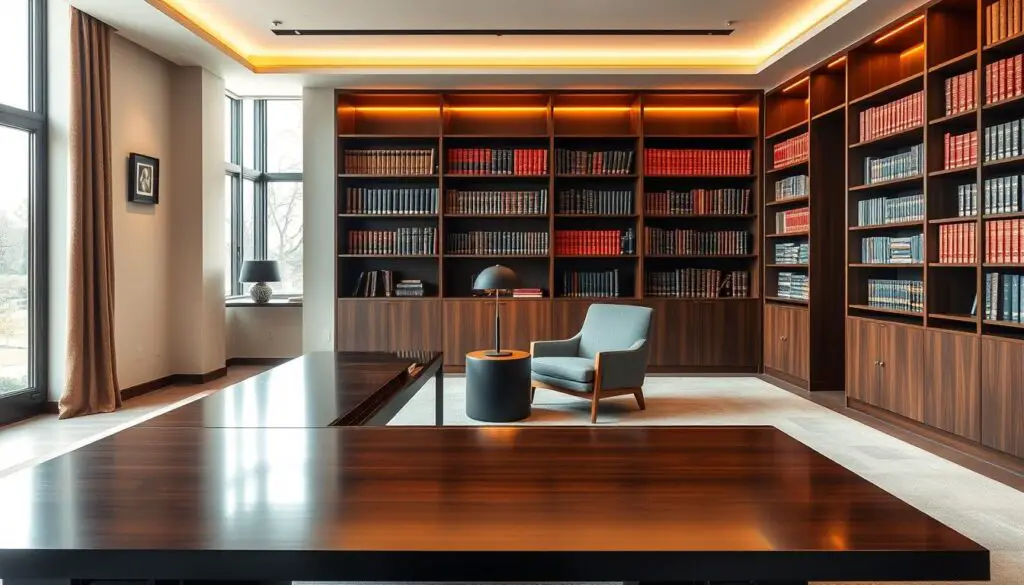
Custom Shelving vs. Built-in Options
Storage was another critical aspect of my interior design plan. I debated between custom shelving and built-in options. Custom shelves offer flexibility, allowing me to adjust the layout as needed. Built-in options, on the other hand, provide a seamless look and maximize space.
Here’s a quick comparison to help you decide:
| Feature | Custom Shelving | Built-in Options |
|---|---|---|
| Flexibility | High | Low |
| Space Efficiency | Moderate | High |
| Cost | Variable | Higher |
Ultimately, I chose a mix of both. Custom bookshelves allowed me to display my collection creatively, while built-in cabinets provided hidden storage for office supplies.
Thoughtful design choices can transform an ordinary room into an inspiring hub for creativity and productivity. By focusing on both style and functionality, I created a space that meets all my needs.
Creative Storage and Functional Design Elements
The key to a well-organized dual-purpose room lies in creative storage and design. When I started planning my space, I knew that effective storage would be the backbone of its functionality. It’s not just about hiding clutter; it’s about creating a seamless blend of practicality and style.
Smart Bookshelf Arrangements and Cabinet Concepts
Bookshelves and cabinets are more than just storage units—they’re design statements. I experimented with different layouts to maximize space without sacrificing aesthetics. Floating shelves added a modern touch, while built-in cabinets kept my office supplies neatly tucked away.
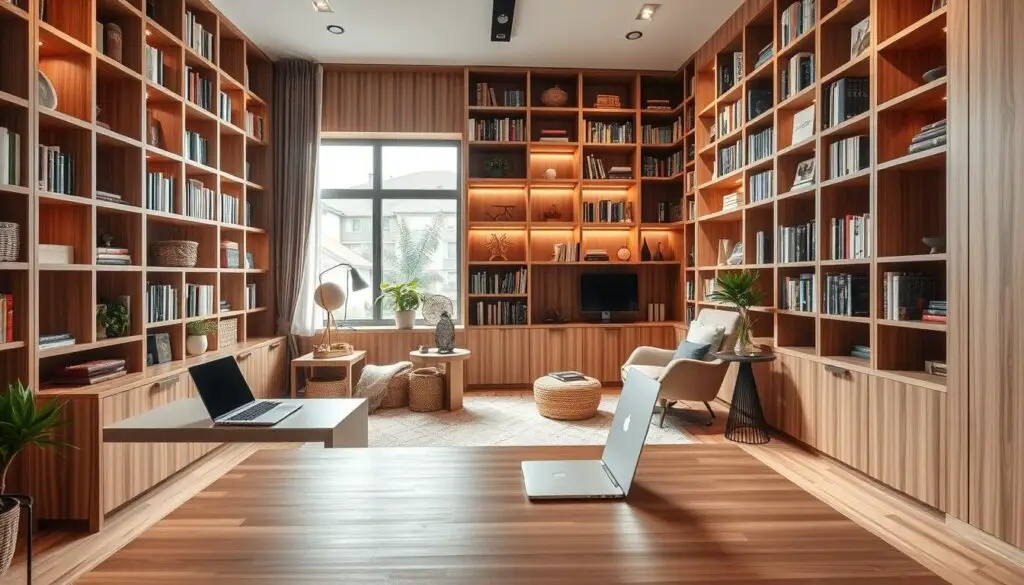
| Option | Pros | Cons |
|---|---|---|
| Floating Shelves | Space-saving, modern look | Limited weight capacity |
| Built-in Cabinets | Seamless design, ample storage | Higher cost |
| Modular Shelving | Customizable, versatile | Requires assembly |
Each option has its strengths, so I chose a mix to suit my needs. Floating shelves showcased my book collection, while built-in cabinets kept the room clutter-free.
Innovative Multi-purpose Furniture Ideas
Multi-purpose furniture is a game-changer for small spaces. I invested in a desk that doubles as a console table and a sofa bed for occasional guests. These pieces not only save space but also add to the room’s functionality.
Here are a few ideas I found particularly useful:
- Ottomans with hidden storage for extra seating and organization.
- Foldable desks that can be tucked away when not in use.
- Bookshelves with built-in desks for a cohesive look.
These solutions allowed me to create a room that’s both efficient and inviting. By focusing on comfort and practicality, I transformed my space into a haven for work and relaxation.
Crafting a Cozy, Personalized Reading & Work Nook
A well-lit, comfortable nook can transform any corner into a haven for reading and working. When I set out to design my space, I focused on creating a balance between functionality and coziness. The right lighting and seating were essential to making the area inviting and practical.
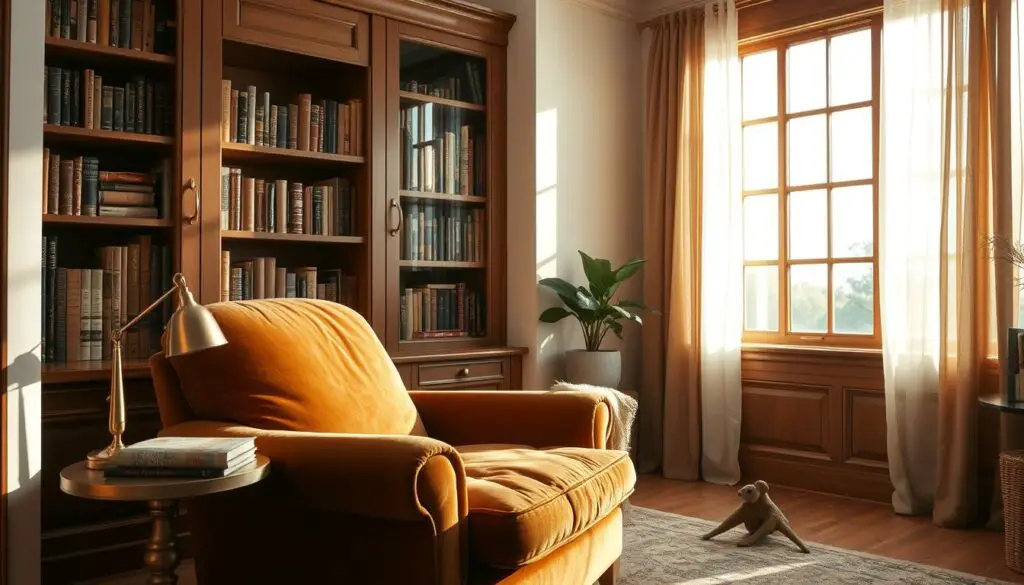
Lighting Options: Natural, Table, and Floor Lamps
Lighting plays a huge role in setting the mood. I started by maximizing natural light, positioning my desk near a window. For evenings, I added a mix of table and floor lamps to create a warm, inviting glow. A lamp with adjustable brightness became my go-to for both work and reading.
Here’s how I balanced the lighting:
- Natural light for daytime productivity.
- Table lamps for focused tasks.
- Floor lamps for a cozy ambiance.
Choosing the Right Chair and Seating Arrangements
Comfort was non-negotiable. I invested in an ergonomic chair for work and a plush armchair for reading. The seating arrangement was designed to support long hours without sacrificing style. A small side table next to the armchair held my coffee and books, making the reading nook even more inviting.
Adding personal touches like a soft throw blanket and a few decorative pillows made the space uniquely mine. These small details turned an ordinary corner into a source of inspiration and relaxation.
By carefully selecting lighting and seating, I created a space that’s both functional and cozy. Whether I’m working or diving into a good book, this nook has become my favorite spot in the house.
Conclusion
Transforming a space into a functional and inspiring area is a journey worth taking. I’ve shared my experience to help you create a workspace that balances productivity and relaxation. Paying attention to details like color, light, and interior design can make all the difference.
Experiment with elements like table arrangements and wall decor to craft a space that feels uniquely yours. The right balance of aesthetics and functionality can turn any living room or corner into a personal sanctuary.
Take your time to explore what sparks your interest. Whether it’s a cozy reading nook by the window or a sleek workspace, every detail matters. Let these ideas inspire you to create a place that reflects your world and enhances your daily life.
Start small, and let your creativity guide the way. Your perfect space is just a few thoughtful changes away.
FAQ
How do I define the purpose of my space?
Start by deciding if the area will focus on work, reading, or both. This helps me choose the right furniture and layout to match my needs.
What’s the best way to blend work and reading vibes?
I like to use a mix of functional furniture, like a desk and a comfy chair, paired with warm lighting and bookshelves to create a balanced atmosphere.
Where should I place my home library workspace?
I look for a quiet spot with plenty of natural light, like near a window or in a cozy corner, to make the space inviting and productive.
How can I maximize space in a small area?
I use vertical storage, like tall bookshelves, and multi-purpose furniture, such as a desk with built-in drawers, to save space while keeping everything organized.
Should I choose custom shelving or built-in options?
It depends on my budget and needs. Built-ins offer a seamless look, while custom shelving lets me adjust the design as my collection grows.
What are some smart bookshelf arrangement ideas?
I group books by size, color, or genre for a neat look. Adding cabinets or baskets helps hide clutter and keeps the space tidy.
How do I create a cozy reading nook?
What lighting works best for a home library workspace?
I combine natural light with adjustable table lamps and floor lamps to ensure the space is well-lit for both work and reading.

